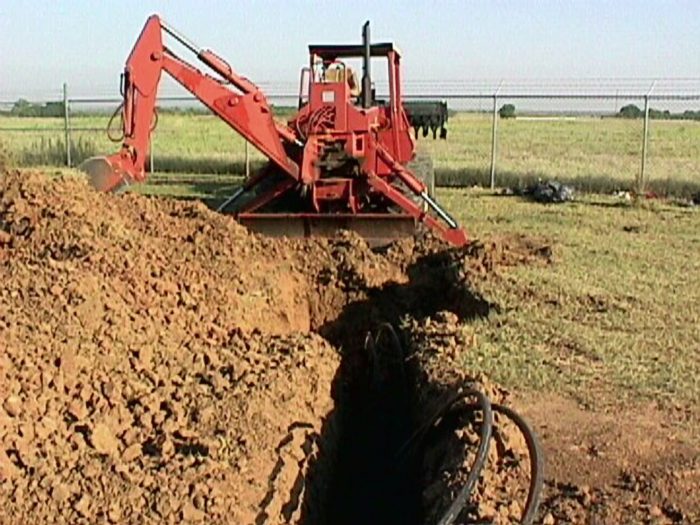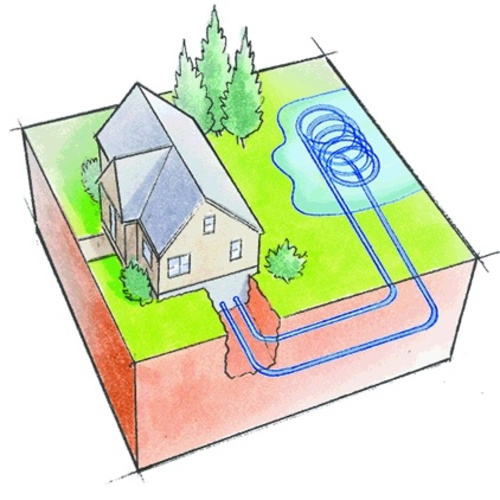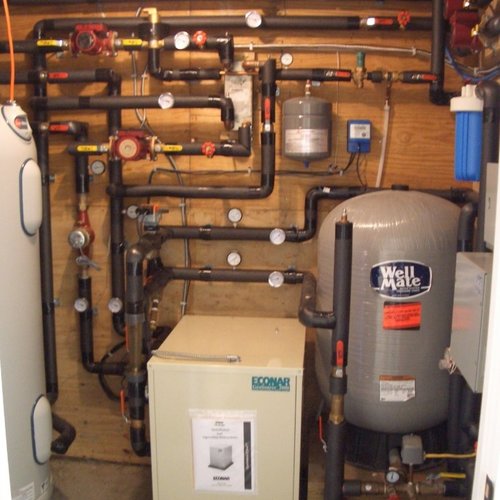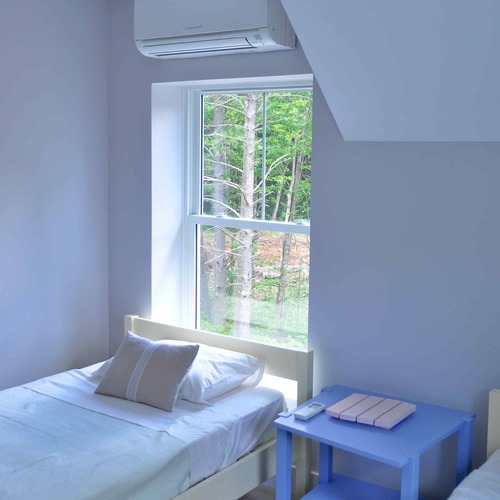
Image Credit: National Renewable Energy Laboratory
A tech startup that began as a “moonshot” project at Google X has raised $2 million in seed money as it promotes a more affordable type of ground-source heat pump.
Details about the system developed by Dandelion were skimpy. The company says that it has developed “clean drilling technology” that will be much less disruptive to property than the current practice of drilling wells or excavating deep trenches for the heat exchange tubing the systems need.
Its website says that the drill makes a bore “just a few inches wide” and a few hundred feet deep so a complete installation can be complete in two or three days with minimal disruptions to a customer’s property.
It wasn’t clear whether Dandelion’s system, which it calls “geothermal heating and cooling,” represents any advance in the compressors, pumps, and other components of current ground-source heat pump technology or amounted only to a new way of drilling holes for the tubing.
For the time being, Dandelion says it is offering the systems to homeowners in upstate New York in the Hudson Valley and Capital region. There was no word on when the company planned an expansion beyond that region.
Lower costs also are promised
The extensive excavation that ground-source heat pumps often require is one sticking point for some homeowners, and so is the cost. Many estimates from experts for a complete system top $40,000, with one as high as $50,000. (See Are Affordable Ground-Source Heat Pumps On the Horizon?). That’s far above the cost of competing technologies.
Dandelion’s site says that homeowners will pay $20,000 for an installed system with no upfront costs. Monthly payments would be less than the $210 a homeowner using $2,500 worth of propane or fuel oil per year would pay.
Dandelion is a spinoff from a two-year project at X, Google’s subsidiary for long-shot projects, according to an announcement posted at BusinessWire. Alphabet calls X the “innovation engine” of the giant tech company.
GBA is seeking additional information from Dandelion and will update this article if more information becomes available.
Weekly Newsletter
Get building science and energy efficiency advice, plus special offers, in your inbox.















7 Comments
Cost
My reading of Dandelion's system is that the $20,000 replaces an existing system. Thus it uses existing ductwork (or piping?), fans or radiators, etc. I assume the cost for new construction would be higher.
Good to see
I'm glad to see this. Minisplits beat out GCHPs because mass production and simple installation brought cost down while advanced variable-speed heat pumps brought efficiency up. GCHPs lost out because they were slower to adopt advanced variable speed heat pumps and water pumps, and because the design and installation were expensive and difficult to get right. And meanwhile PV costs came down to the point where a GCHP couldn't be justified as a good way to get to net zero, when a minisplit plus a little extra PV
But GCHPs are inherently capable of higher efficiency, especially on the worse cold winter nights and hot summer days. They substantially reduced the overall annual energy consumption of a building, but they reduce the peak load even more. That benefits the grid, and makes it easier to accommodate more renewables on the grid. Eventually the way consumers are charged will reflect that as well, so the cost to run a GCHP will become lower
I've been hoping that someone would do something like this. There have been a few people saying that new small directional drilling rigs can be an inexpensive, less disruptive way to install the loops. I'm not sure whether that's what this company is doing, or whether it's still a vertical bore hole, but with a smaller drilling rig. In either case, it seems possible to get the cost of the well down significantly with a rig designed to do just what is needed and no more. Getting the installation right is also quite possible with the right expertise on board. The way they are rolling this out, first in one region, sounds like they are making sure they have the right skilled designers and installers ready. The costs they are talking about are lower than a standard GSHP installation, but not so low as to lack credibility. So I find that encouraging as well.
As for the cost of a new installation vs. a retrofit, if it's going into a well insulated well air-sealed house, and they are doing a good manual J, the system for a new installation could be enough smaller than a retrofit system that they would come out with a lower cost rather than a higher cost.
I hope they will also eventually offer water-water heat pumps and hydronic delivery to low-profile fan coils and other emitters. One you have the skill set for the plumbing on the ground loop side, you can apply the same skills to the other side, and avoid the energy, space, and installation cost of ducts, especially in retrofits of houses with legacy hydronic heating systems and no existing ducts, and retrofits of houses with leaky ducts in unconditioned attics.
Skimpy? Dandelion's website is nearly content-free!
A picture of their noo-improoved drilling technology would be interesting, but it's not clear whether that is their special-sauce, or if their $0 down EZ finance business model is the real innovation.
It's about business model & big-data market focus, not drilling.
There is some discussion about the business model and drilling technology in today's GTM Energy Gang podcast, beginning at about 15:35 :
https://soundcloud.com/the-energy-gang/californias-cap-and-trade-win
Sonic drilling isn't really new tech, but it works it's pretty fast. It's basically an oversized hammer-drill running at 50-200 hits per second.
The innovation Dandelion is bringing to the table is to structure the financing similarly to the $0 down solar companies, but more importantly, to selectively target the marketing in an EXTREMELY focused way by using big data to figure out which house are being heated with propane or oil-fired hot air furnaces, in locations where the soils are amenable to sonic drilling.
This takes a fair amount of data mining and compute-crunch sifting on both public real estate, gas company, and geology data sets (some soils/rocks are harder on the equipment and drill slower than others), something that mom & pop GSHP companies aren't really in a position to do. By limiting it to hot air heating and easily sonic-drillable soils they can take set of 2 or 3 pre-packaged cookie-cutter GSHP retrofit designs and cover the majority of their focus market without the need to do a lot of custom re-design or careful quoting.
Incentives?
Not clear from their site whether the $20,000 cost is before or after tax credits or other incentives.
GTM podcast
Thanks for the link to the GTM podcast, Dana. Their discussion had a lot more information than the company web site, for sure.
The discussion in the podcast seems to exaggerate the scale of the drilling rigs being used in typical practice: I don't think huge oil/gas drilling rigs that require a big crew to operate are common. I'm sure that happens, particularly in oil/gas regions at times when there are rigs sitting idle, but around here it's done with water-well drilling rigs, which fit on a modest size truck and are operated by one person. They typically drill 4" holes, and the rigs typically max out somewhere between 300' and 600' of depth. Nonetheless, there are real savings possible there. It's not a new idea to have a rig that is specifically intended for GCHP wells, or to use a smaller rig, but I think that opportunity is underutilized. For a GCHP, you don't need 600' depth even if the design says you need that much: you can use 6 wells each 100' deep. And with them plumbed in parallel, you can reduce the pumping power to circulate water in them vs. one 600' deep well.
With numerous wells to connect, there could be a need for a lot of trenching, which adds cost and makes a mess. Directional boring can avoid that by making multiple wells go off in different directions from one well head. And you can bore a longer well for a given depth going at a diagonal or even going horizontally at 20' depth. My understanding is the size of the rig required scales up rapidly with more depth, but not so much with horizontal length. And by avoiding going deep you can sometimes avoid boring through rock. Rock can be good for thermal performance, but without enough soil involved you don't need rock. I don't know whether this company is using directional boring, but that seems like a really good opportunity for a company like them.
The podcast also exaggerates the level of sophisticated work needed to find residences that aren't served by natural gas. There are plenty of regions where there's simply no natural gas service at all. Eventually, you'd want to move beyond those regions but it's not so hard to find big areas to start with where nobody has natural gas, just by looking up where the PUC has a utility in place.
Finally, the podcast talks about schools being a great place to apply GCHPs because the schools are unoccupied in the summer and that gives the well temperature a chance to recover. In regions where air conditioning energy use dominates over heating, that would sometimes be true--the two uses might be more balanced with less A/C usage. But in much of the country where heating still dominates, air conditioning over the summer actually helps balance heat flow in and out of the ground, and you'd need more or deeper wells without A/C use in the summer.
Would be interesting to know
Would be interesting to know how the economics compare to horizontal loops, perhaps with equipment specifically designed to trench efficiently.
Log in or create an account to post a comment.
Sign up Log in